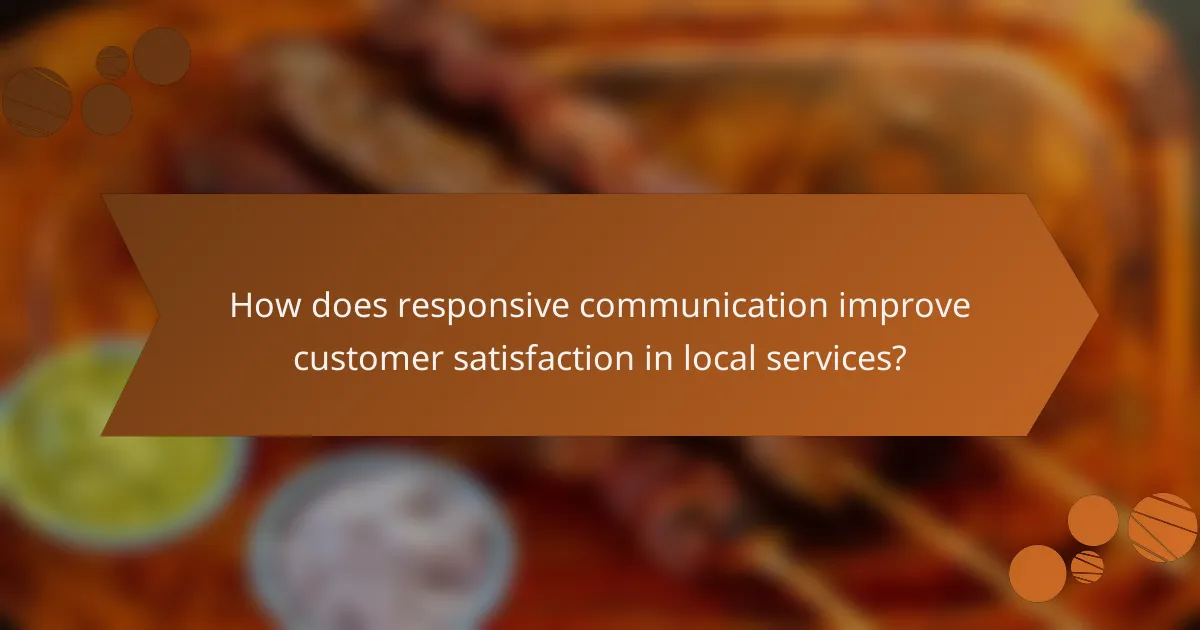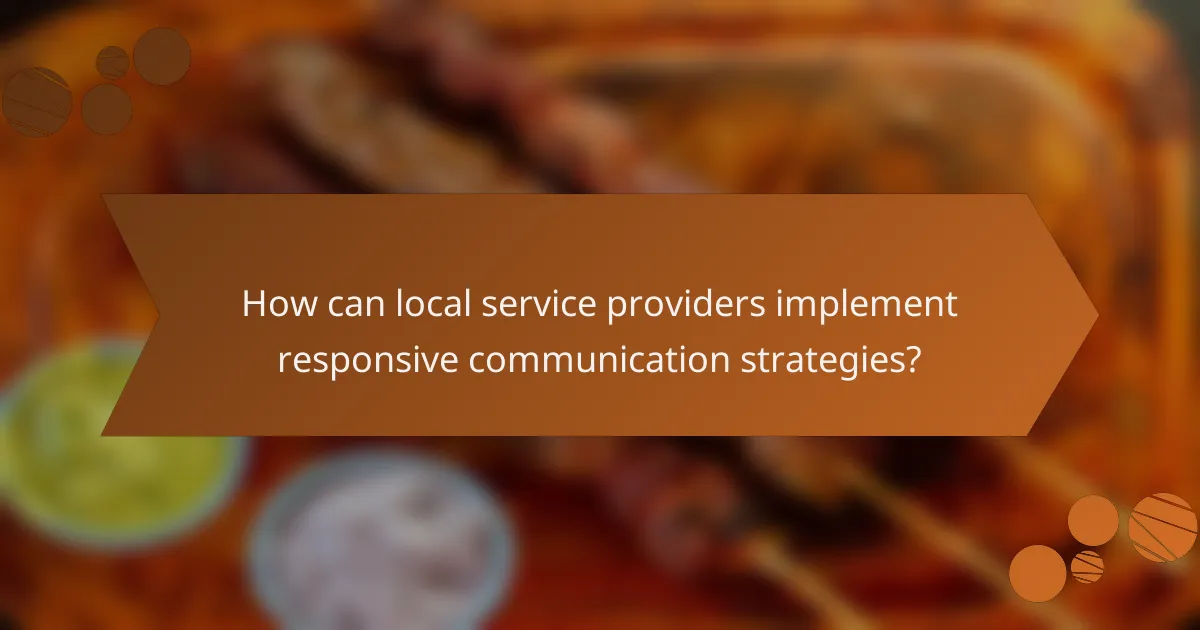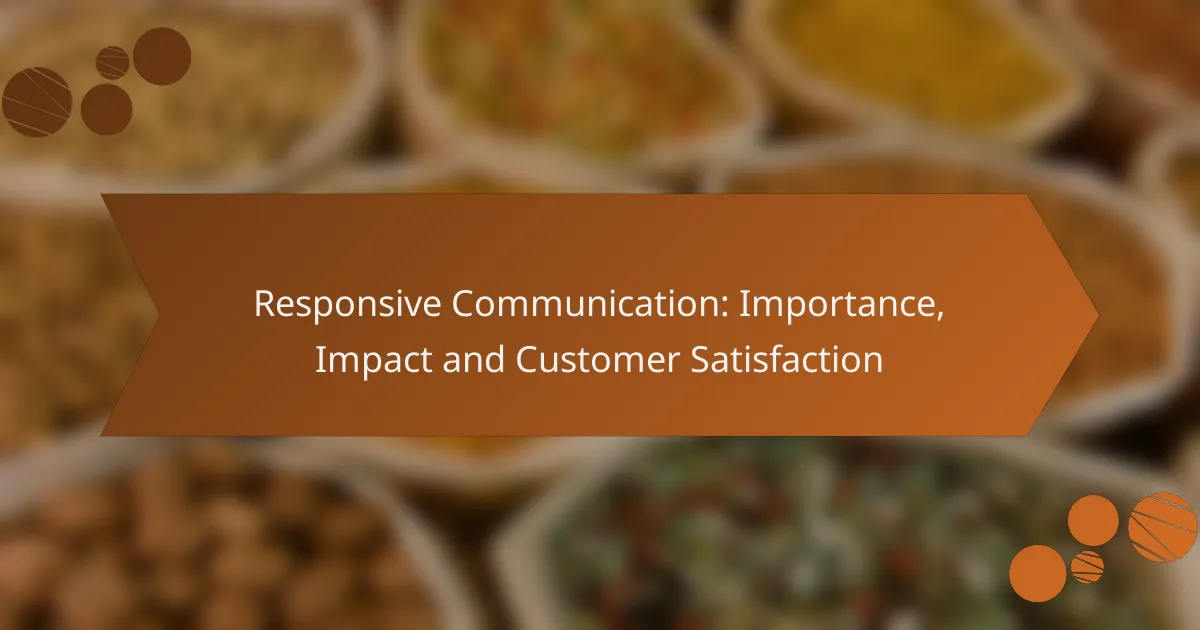Responsive communication is crucial for enhancing customer satisfaction in local services, as it ensures clients feel heard and valued. By prioritizing clarity, attentiveness, and adaptability, service providers can foster stronger relationships and create a more positive experience for their customers.

How does responsive communication improve customer satisfaction in local services?
Responsive communication significantly enhances customer satisfaction in local services by ensuring that clients feel heard and valued. Quick and effective interactions can lead to stronger relationships and a more positive overall experience.
Timely responses enhance trust
When local service providers respond promptly to inquiries or issues, it builds trust with customers. Timeliness demonstrates that the business values its clients and is committed to addressing their needs.
For instance, a local plumbing service that replies within minutes to a service request is likely to be perceived as reliable. Aim for response times of under an hour for inquiries to foster confidence in your services.
Personalized interactions increase loyalty
Personalized communication makes customers feel special and appreciated, which can lead to increased loyalty. Tailoring messages to individual preferences or past interactions shows that a business understands its clients.
For example, a local café that remembers a customer’s favorite drink can create a more engaging experience. Use customer data to personalize follow-ups and offers, enhancing the likelihood of repeat business.
Clear information reduces confusion
Providing clear and concise information helps eliminate confusion and sets proper expectations. When customers understand what to expect, they are more likely to feel satisfied with the service provided.
For instance, a local handyman should clearly outline service costs and timelines upfront. Use straightforward language and avoid jargon to ensure that all customers can easily grasp the information shared.
Proactive outreach fosters engagement
Proactively reaching out to customers can significantly enhance engagement and satisfaction. Regular check-ins or follow-ups show that a business cares about its clients beyond the initial transaction.
For example, a local landscaping company might send seasonal tips or reminders about maintenance. Establish a routine for outreach, such as quarterly newsletters or satisfaction surveys, to keep customers connected and informed.

What are the key components of effective responsive communication?
Effective responsive communication hinges on clarity, attentiveness, and adaptability. These components ensure that messages are understood and that feedback is actively incorporated, fostering a positive interaction experience.
Active listening techniques
Active listening involves fully concentrating on the speaker, understanding their message, and responding thoughtfully. Techniques include maintaining eye contact, nodding, and paraphrasing what the speaker has said to confirm understanding. This not only shows respect but also encourages open dialogue.
To enhance active listening, avoid interrupting and allow pauses for the speaker to express their thoughts completely. Practicing mindfulness can also help in staying present during conversations, leading to more meaningful exchanges.
Utilizing multiple communication channels
Employing various communication channels—such as email, phone calls, and instant messaging—can significantly improve responsiveness. Different situations may call for different methods; for example, urgent matters might be best handled via phone, while detailed information can be effectively shared through email.
Consider the preferences of your audience when choosing channels. Some may favor visual communication, while others might prefer text-based interactions. Offering multiple options can enhance engagement and satisfaction.
Feedback mechanisms for improvement
Implementing feedback mechanisms is crucial for refining communication practices. Surveys, follow-up questions, and informal check-ins can provide valuable insights into how effectively messages are being received. This feedback loop allows for continuous improvement.
Encourage a culture where feedback is welcomed and acted upon. Regularly review feedback to identify trends and areas for enhancement, ensuring that communication remains effective and responsive to the needs of all parties involved.

How can local service providers implement responsive communication strategies?
Local service providers can enhance responsive communication strategies by focusing on staff training, utilizing technology, and establishing clear protocols. These approaches ensure timely and effective interactions with customers, leading to improved satisfaction and loyalty.
Training staff on communication skills
Training staff in communication skills is essential for fostering responsive interactions. This training should cover active listening, empathy, and clarity in messaging, enabling employees to address customer needs effectively. Regular workshops and role-playing scenarios can help reinforce these skills.
Additionally, providing feedback and coaching can help staff refine their communication techniques. Encouraging a culture of open dialogue among team members can further enhance overall responsiveness.
Leveraging technology for real-time interactions
Utilizing technology is crucial for enabling real-time communication with customers. Tools such as live chat, social media messaging, and customer relationship management (CRM) systems can facilitate immediate responses to inquiries. Implementing these technologies can significantly reduce response times and improve customer experience.
Service providers should also consider mobile applications that allow customers to reach out easily. Offering multiple channels for communication ensures that customers can choose their preferred method, enhancing overall satisfaction.
Establishing clear communication protocols
Clear communication protocols are vital for maintaining consistency and efficiency in customer interactions. Service providers should outline specific guidelines for responding to inquiries, including expected response times and escalation procedures for complex issues. This clarity helps staff manage customer expectations effectively.
Regularly reviewing and updating these protocols based on customer feedback and changing needs can ensure they remain relevant. Additionally, sharing these protocols with customers can build trust and transparency in the service relationship.

What role does technology play in responsive communication?
Technology is crucial for enabling responsive communication by facilitating quick interactions and efficient tracking of customer needs. Tools like chatbots, CRM systems, and social media platforms enhance the speed and quality of customer service, leading to improved satisfaction.
Chatbots for immediate assistance
Chatbots provide instant responses to customer inquiries, significantly reducing wait times. They can handle a variety of tasks, such as answering FAQs, booking appointments, or providing product information, often available 24/7.
When implementing chatbots, ensure they are programmed with a comprehensive knowledge base and can escalate complex issues to human agents. This balance helps maintain customer satisfaction while leveraging automation.
CRM systems for tracking interactions
Customer Relationship Management (CRM) systems are essential for tracking all interactions with customers, allowing businesses to personalize communication. These systems store data on customer preferences, purchase history, and previous inquiries, which can be accessed by agents to provide tailored responses.
Using a CRM effectively involves regularly updating customer information and analyzing interaction data to identify trends. This practice can enhance service quality and foster long-term customer relationships.
Social media for real-time engagement
Social media platforms enable businesses to engage with customers in real time, addressing concerns and feedback promptly. This immediacy can significantly enhance customer loyalty and brand perception.
To maximize social media effectiveness, maintain an active presence and respond to comments and messages quickly. Establish guidelines for tone and response times to ensure consistent and professional communication.

How can local businesses measure the impact of responsive communication?
Local businesses can measure the impact of responsive communication through various methods that assess customer feedback and engagement. These methods provide insights into how effectively a business addresses customer inquiries and concerns, ultimately influencing customer satisfaction and loyalty.
Customer satisfaction surveys
Customer satisfaction surveys are a direct way to gauge how well a business meets customer expectations. By asking customers to rate their experiences, businesses can identify strengths and weaknesses in their communication practices. Surveys can be distributed via email, social media, or in-store, and should include both quantitative ratings and open-ended questions for qualitative feedback.
To maximize response rates, keep surveys concise and offer incentives, such as discounts or loyalty points. Aim for a response rate of at least 10-20% to ensure the data is representative of your customer base.
Net Promoter Score (NPS) analysis
The Net Promoter Score (NPS) is a widely used metric that measures customer loyalty based on their likelihood to recommend a business to others. Customers are typically asked to rate this on a scale from 0 to 10, allowing businesses to classify them as promoters, passives, or detractors. Analyzing NPS can reveal how responsive communication influences overall customer sentiment.
To calculate NPS, subtract the percentage of detractors from the percentage of promoters. A positive score indicates a healthy level of customer loyalty, while a negative score suggests areas needing improvement. Regularly tracking NPS can help businesses adjust their communication strategies effectively.
Response time metrics
Response time metrics measure how quickly a business addresses customer inquiries, which is crucial for assessing the effectiveness of responsive communication. Businesses should track average response times across different channels, such as email, social media, and phone calls. Aim for response times in the low minutes for digital inquiries and within a few seconds for live chat.
Monitoring response times helps identify bottlenecks and areas for improvement. Consider setting benchmarks based on industry standards or competitor performance to ensure your business remains competitive. Regularly reviewing these metrics can lead to enhanced customer satisfaction and loyalty.

What are the challenges of maintaining responsive communication?
Maintaining responsive communication can be difficult due to various factors such as resource constraints, the need to balance speed with quality, and the evolving expectations of customers. These challenges can significantly impact customer satisfaction and overall business effectiveness.
Resource limitations in small businesses
Small businesses often face significant resource limitations, including budget constraints and a lack of personnel. This can hinder their ability to respond quickly to customer inquiries and feedback, which is crucial for building strong relationships.
To mitigate these challenges, small businesses can leverage technology, such as automated messaging systems or customer relationship management (CRM) tools, to streamline communication. Prioritizing customer queries based on urgency can also help manage limited resources effectively.
Balancing speed with quality
Striking a balance between speed and quality in communication is essential yet challenging. Quick responses can lead to misunderstandings or insufficient information, while overly detailed replies may delay resolution times.
Businesses should aim for a response time of under a few hours for most inquiries while ensuring that the information provided is clear and actionable. Implementing standard operating procedures for common queries can help maintain this balance, ensuring that customers receive timely and accurate responses.
